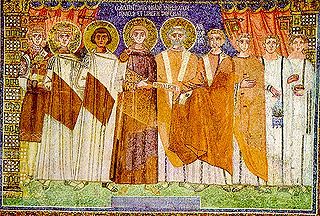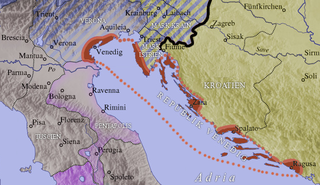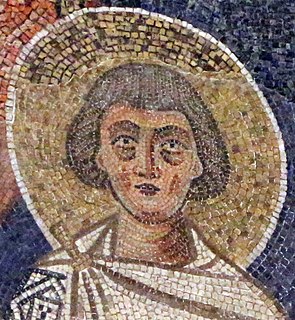Constantine most often refers to:
The 660s decade ran from January 1, 660, to December 31, 669.

Year 663 (DCLXIII) was a common year starting on Sunday of the Julian calendar. The denomination 663 for this year has been used since the early medieval period, when the Anno Domini calendar era became the prevalent method in Europe for naming years.

Year 668 (DCLXVIII) was a leap year starting on Saturday of the Julian calendar. The denomination 668 for this year has been used since the early medieval period, when the Anno Domini calendar era became the prevalent method in Europe for naming years.

Heraclius Constantine, often enumerated as Constantine III, was one of the shortest reigning Byzantine emperors, ruling for three months in 641. He was the eldest son of Emperor Heraclius and his first wife Eudokia.

Constans II was the emperor of the Byzantine Empire from 641 to 668. He was nicknamed "the Bearded", was emperor of the Byzantine Empire from 641 to 668. He was the last attested emperor to serve as consul, in 642, although the office continued to exist until the reign of Leo VI the Wise.

Constantine IV, called the Younger and sometimes incorrectly Pogonatos out of confusion with his father, was Byzantine Emperor from 668 to 685. His reign saw the first serious check to nearly 50 years of uninterrupted Islamic expansion, while his calling of the Sixth Ecumenical Council saw the end of the monothelitism controversy in the Byzantine Empire; for this, he is venerated as a saint in the Eastern Orthodox Church, with his feast day on September 3. He successfully defended Constantinople from the Arabs.

The Duchy of Benevento was the southernmost Lombard duchy in the Italian Peninsula that was centred on Benevento, a city in Southern Italy. Lombard dukes ruled Benevento from 571 to 1077, when it was conquered by the Normans for four years before it was given to the Pope. Being cut off from the rest of the Lombard possessions by the papal Duchy of Rome, Benevento was practically independent from the start. Only during the reigns of Grimoald, King of the Lombards and the kings from Liutprand on was the duchy closely tied to the kingdom. After the fall of the kingdom, however, it was the sole Lombard territory to continue to exist as a rump state, maintaining its de facto independence for nearly 300 years, although it was divided after 849.

Welf I was Duke of Bavaria from 1070 to 1077 and from 1096 to his death. He was the first member of the Welf branch of the House of Este. In the genealogy of the Elder House of Welf he is counted as Welf IV.

The Duchy of Naples began as a Byzantine province that was constituted in the seventh century, in the reduced coastal lands that the Lombards had not conquered during their invasion of Italy in the sixth century. It was governed by a military commander (dux), and rapidly became a de facto independent state, lasting more than five centuries during the Early and High Middle Ages. Naples remains a significant metropolitan city in present-day Italy.
The Dukes of Naples were the military commanders of the ducatus Neapolitanus, a Byzantine outpost in Italy, one of the few remaining after the conquest of the Lombards. In 661, Emperor Constans II, highly interested in south Italian affairs, appointed a Neapolitan named Basil dux or magister militum. Thereafter a line of dukes, often largely independent and dynastic from the mid-ninth century, ruled until the coming of the Normans, a new menace they could not weather. The thirty-ninth and last duke, Sergius VII, surrendered his city to King Roger II of Sicily in 1137.
The House of Ardenne–Verdun was a branch of the House of Ardenne, one of the first documented medieval European noble families, centered on Verdun. The family dominated in the Duchy of Lotharingia (Lorraine) in the 10th and 11th centuries. All members descended from Cunigunda of France, a granddaughter of the West Frankish king Louis the Stammerer. She married twice but all or most of her children were children of her first husband, Count Palatine Wigeric of Lotharingia. The other main branches of the House of Ardennes were the House of Ardenne–Luxembourg, and the House of Ardenne–Bar.

The March of Istria was originally a Carolingian frontier march covering the Istrian peninsula and surrounding territory conquered by Charlemagne's son Pepin of Italy in 789. After 1364, it was the name of the Istrian province of the Habsburg monarchy, the Austrian Empire and Austria-Hungary.
Fausta was the Byzantine empress as the wife of Constans II.
The Typos of Constans was an edict issued by eastern Roman emperor Constans II in 648 in an attempt to defuse the confusion and arguments over the Christological doctrine of Monotheletism. For over two centuries, there had been a bitter debate regarding the nature of Christ: the orthodox Chalcedonian position defined Christ as having two natures in one person, whereas Miaphysite opponents contended that Jesus Christ possessed but a single nature. At the time, the Byzantine Empire had been at near constant war for fifty years and had lost large territories. It was under great pressure to establish domestic unity. This was hampered by the large number of Byzantines who rejected the Council of Chalcedon in favour of Monophysitism.

Heraclius was Byzantine co-emperor from 659 to 681. He was the son of Emperor Constans II and Fausta, who was elevated in 659, before his father departed for Italy. After the death of Constans, Heraclius' brother Constantine IV ascended the throne as senior emperor. Constantine attempted to have both Heraclius and Tiberius removed as co-emperors. However, this sparked a popular revolt in 681. Constantine ended the revolt by promising to accede to the demands of the rebels, sending them home, but bringing their leaders into Constantinople. Once there, Constantine had them executed, then imprisoned Tiberius and Heraclius and had their noses slit, after which point they disappear from history.

Tiberius was Byzantine co-emperor from 659 to 681. He was the son of Constans II and Fausta, who was elevated in 659, before his father departed for Italy. After the death of Constans, Tiberius' brother Constantine IV, ascended the throne as senior emperor. Constantine attempted to have both Tiberius and Heraclius removed as co-emperors, which sparked a popular revolt, in 681. Constantine ended the revolt by promising to accede to the demands of the rebels, sending them home, but bringing their leaders into Constantinople. Once there, Constantine had them executed, then imprisoned Tiberius and Heraclius and had them mutilated, after which point they disappear from history.
Martinus or Marinus was caesar of the Byzantine Empire from c. 638–September/October 641. Martinus was the son of Emperor Heraclius and Empress Martina. Under Heraclius, Martinus was elevated to caesar in c. 638. Heraclius left the Byzantine Empire to two of Martinus' brothers, Constantine III and Heraklonas; Constantine soon died of tuberculosis, though some of his partisans alleged that he was poisoned by Martina. One such partisan, Valentinus, led troops to Chalcedon to force Martina to make Constans II, the son of Constantine, co-emperor. Valentinus seized Constantinople regardless in September/October 641, and deposed Martina, Heraklonas, and Martinus, and cut off Martinus' nose and emasculated him, before exiling him to Rhodes.